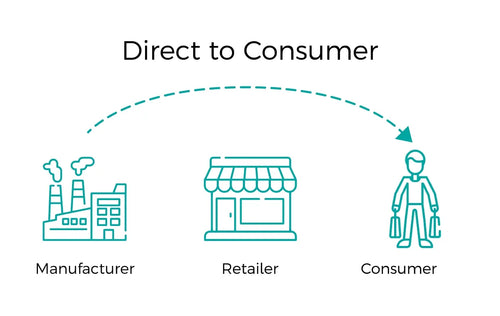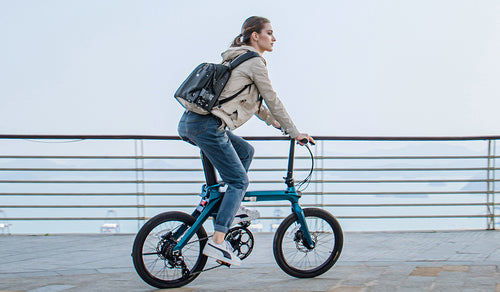In this article, we'll take a closer look at various aspects of charging electric bikes, including:
- Different ways of charging electric bikes
- How to charge electric bikes with alternative energy like generators and solar panels
- Identifying when to charge electric bikes
- Knowing how long it takes to charge electric bike batteries
- Tips on how to maximize bike battery life
- And more!
Before we get into it, allow us to set your mind at ease. Charging electric bikes is simple, cost-effective, and so versatile that you can do it almost anywhere. Let's take a look.
Ways to Charge Electric Bikes
While there may be subtle differences between the charging methods of one bike brand and another, the basics often remain the same. In the following sections, we'll look at some of the most common charging methods, as well as a few valuable alternatives.
1. Remove the Battery to Charge It
Of the many ways to charge electric bikes, this is among the most popular ones. Let's take a look at how to do this, step-by-step:
- Switch off the electric bike to ensure that you can safely remove the battery.
- If your electric bike incorporates a battery lock, it is time to unlock it. If not, release the clips that hold the battery in place.
- Remove the battery from the bike. In most cases, it should simply slide off the bike. However, in some models, you may have to remove the seat before you can get to the battery.
- Plug the charger into a compatible electrical outlet.
- Check for a green LED or another indicator showing the battery is charging.
- Disconnect the battery once the charging process is complete. Typically, it shouldn't take longer than six hours, but it may take longer on the first charge or if the battery has become seriously depleted.
Pro tip: Never leave your battery on charge when fully charged. Doing so can lead to overheating (or other safety hazards) and significantly shorten your bike's battery life.
The main advantage of removing the battery to charge it is that you don't have to lug the whole bike around. You can easily place the battery on a table, the floor, or another level surface, where you can keep an eye on it.
2. Charge the Battery in Place
If you're wondering how to charge electric bikes with as little effort as possible, this might be your ideal option, especially if you have a bike that requires seat removal before removing the battery. In that case, charging in place might be more manageable.
Here's how to charge your battery while it's connected to your electric bike, step by step:
- Ensure that you locate your bike close to a power outlet.
- Apply the kickstand, and ensure that the bike is in a stable position. You want the bike to stay upright while charging.
- Locate the charging port on the battery - it should be on the upper side or one of the sides. Some bikes may have hidden charging ports. If you can't see the port, look for a sliding compartment that might cover it.
- Plug the charging cable into an electrical outlet near your bike, then check that the indicator light comes on. If you don't see an indicator light, the charger may not be getting power.
- Plug the charger into the battery.
- Please wait until the battery reaches full capacity before unplugging it. The battery or charger should have an indicator showing the battery has charged fully. In many cases, the indicator light changes color once the battery is full.
The main advantage of charging the battery on the bike is that you don't have to struggle through the removal process. That makes the process much easier.
3. Charge The Bike in a Docking Station
Docking stations are one of the most popular new charging fads for electric bikes. To use this device, you simply need to:
- Lock your bike into place on the provided stand. The docking station has conveniently situated "arms" to help keep your e-Bike in place while charging.
- Plug the bike charger into the provided port and connect the battery, or
- Plug the bike's battery directly into the provided charging dock. The charging dock may have either or both outlet types depending on the model.
- Wait for the bike to finish charging.
This bike-charging method is becoming so popular that many countries have started building public docking stations. Some of these nations even make the docking stations solar-powered, making them more environmentally friendly.
How To Charge an Electric Bike With a Solar Panel
If you want to know how to charge electric bikes while camping or far from home, alternative energy sources are well-worth considering. From small portable solar panels to miniature wind turbines and hydroelectric systems, many such energy sources are so tiny that you can easily fit them in a backpack.
With the advent of affordable, lightweight solar panels, solar energy has become a viable way to charge electric bikes. While it's not one of the most commonly used methods, it can save money and reduce environmental impact. Let's take a look at what you need to have in order to charge your electric bike with a solar panel:
- Your bike's original charger or a generic charger that works on your bike model.
- A solar panel - if you're going to use it while camping or on trips, we'd suggest a lightweight or flexible type panel.
- A solar charge controller to ensure that you don't overload your bike's battery charger with too much power.
- Alternatively - a small, lightweight solar inverter kit that incorporates a solar panel, inverter, and charge controller into a single device. The smaller models can be helpful since you'd only need to carry one device rather than multiple parts.
Now that you know what you need to charge your bike with solar power, let's look at how to use these items to accomplish that purpose:
WITH AN INVERTER KIT
- If you're using an all-in-one inverter kit; you should only need to plug the bike's charger into the output on the device.
- If it's a simple electrical outlet, you only need to plug the charger in after ensuring you have set the inverter to the correct charge output. You can check your bike's electricity requirements or read the label on the battery charger before setting the charge controller on your inverter kit.
- If the inverter kit has a wire outlet rather than an electrical socket, you can purchase adaptors to connect those wires directly to your battery charger. Take care still to set the charge controller to the correct voltage. Failure to do so can lead to burning out your charger.
USING INDIVIDUAL COMPONENTS
When you apply the same principles to individual components rather than a pre-assembled device, there are a few more things to bear in mind. In this case, you want to adhere to the following steps:
- Connect the solar panel to the charge controller. The charge controller instruction manual should give you detailed information about where the input wires connect.
- Set the charge controller to the appropriate voltage, which you can find on the electric bike battery charger.
- Connect the output wires from the solar charge controller to the bike battery charger. In this case, you'll have to add adaptors to the cables and possibly the charger to ensure they can
- connect. Ensure that you connect the adaptors and wires to the correct polarity, or you may blow the charger's fuse.
- Connect the battery to the charger, switch on the charge controller, and place the solar panel in the sun.
- Check that the charge indicator light is on, and let the battery charge fully.
Once you've used the system once or twice, you can leave everything connected and take it with you. When you need to charge your bike, place the solar panel in the sunlight and plug the battery into the charger.
This technique is a fantastic way to charge your bike if you spend a lot of time traveling and need access to standard power outlets. It's also an excellent way to save costs, since you don't have to pay for power.
Can You Charge an Electric Bike With a Generator?
You definitely can! The only thing you need to bear in mind is that you need a generator that’s big enough to power the charger. For most brands, that means you'll need a generator that can power at least 500 Watts.
If you use a generator to charge your electric bike battery, you might want to consider the value of a surge protector. This nifty little device slips into the electrical outlet on your generator and protects whatever you're powering from surges if anything goes wrong.
Also, charging your electric bike battery using a generator is the same as using a standard power source.
How Do You Know When To Charge Your Electric Bike Battery?
Charging your electric bike is easy, but how do you know when to charge them?
There are various clues you can rely on, but one of the easiest things to do is get a charge tester. Whether it's a charge tester for electric bikes or a multimeter, you can quickly check how much power your battery gives off.
A fully-charged battery should give out the amount of power that it's rated for. I.E., 36 to 48 volts in most cases. A discharged battery will show no voltage.
It would be best if you aimed to charge the battery when it reaches a charge level of around 30%. If it goes lower than that, it's okay. It's good to discharge your battery entirely now and then. Doing so allows the battery to charge fully and reload any cells that may not be charging with partial charges.
How Long Does It Take To Charge an e-Bike?
Now that you know how to charge electric bikes and when to charge them, the next question is, for how long?
The answer to this question is variable since not all e-Bikes have the same battery capacity.
That said, most electric bikes usually have a 36-volt or 48-volt battery. However, some models come with a 52-volt battery which can provide more power, more consistently, for more extended periods.
On average, you can expect a 36 or 48-volt battery to charge for around six to eight hours. A 52-volt battery may charge for closer to ten or twelve hours.
Factors That Affect How Frequently You Charge Electric Bikes
Many different factors affect how long your battery lasts between charges. Depending on these factors, you may need to charge frequently or only very rarely. Let's take a look at them.
1. The Rider
How you ride your bike can impact your bike's battery life, as can certain things about you. For example, all the following factors come into play:
- Riding Speed - One of the main elements to consider is how fast you ride. Contrary to popular belief, riding faster on your e-bike will make the battery life shorter rather than longer. This effect occurs because the motor works harder to keep up when you pedal faster.
- Your Weight - All electric bikes have a specific weight rating. You can safely use the bike if you fit into that weight bracket. Anyone weighing more than the rating will go through battery power exceptionally quickly. Furthermore, the heavier you are (even within the weight bracket), the more battery you'll use.
- Your Riding Style - The way you ride also affects battery life. For instance, if you tend to pedal for a while and then let the motor do the work, you'll use more battery power. You'll also use up more of it if you tend to do jumps or other tricks while riding.
2. Use Frequency
Naturally, the amount of time you spend using your electric bike can also significantly affect how often you'll need to charge it. If you ride the bike daily, even for reasonably short distances, you'll need to charge it more often than someone who uses their cycle once a month.
The short version is:
- Shorter distances ridden less often result in longer times between charges.
- Longer distances ridden more often lead to shorter charge intervals.
3. Battery Age
Batteries generally become less effective as they age. If you use your bike regularly, it can easily be down to 50% battery capacity by the end of its first year.
Assuming you're more of an average user and take your bike out for short distances a few times a week, you'll probably get around two years out of your battery.
Most experts recommend replacing your battery every year or two, if you’re an average user. For individuals using their e-bike as their primary mode of transport, replacing the battery every 10 to 12 months is probably a good idea.
Newer batteries generally have better power retention, and will last longer.
4. Type of Terrain
The type of area where you like to ride can make a massive difference to the range you get out of your bike's battery. If you prefer riding on smooth terrains, like well-maintained sidewalks, you won't have to charge your bike all that often. On the other hand, riding in the mountains or through hilly meadows is likely to shorten your bike's range significantly.
5. The Bike's Assistance Level
Depending on the level of assistance you expect from your bike, your battery life may become either shorter or longer. For instance, your battery will last longer if you only need help when riding up steep hills or managing other challenging areas.
If you expect assistance with even the most straightforward parts of your route, your bike will have a much shorter range.
In short, using the lowest possible assist level will give you the highest potential battery lifespan between charges.
6. Tire Type and Condition
The kinds of tires you use can significantly impact your e-bike's battery life, as can the tire condition.
If you use thick, heavy tires, or those with a really deep tread, it will shorten your battery life considerably. The same is true for tires with defects or that have deflated to some degree.
All these conditions make the bike tires less effective and result in the bike's motor having to work harder to accomplish the same results. More motor power equals shorter battery life. Efficient tires lead to less motor power and longer battery life.
Tips for Maintaining Your Bike's Battery Life
As with any type of battery, you can extend your electric bike's battery life through proper care. Below are some of our top tips for maintaining e-Bike batteries.
Maintain a Balance With Battery Discharges
Another factor that affects charge time is how much the battery has discharged. A fully-discharged battery may take considerably longer to charge than its partially discharged counterpart.
A partially discharged battery will almost always charge more quickly, and many experts recommend charging your battery while it still has between 30% and 60% of battery power.
However, if you constantly discharge a battery only part-way, then recharge it, it can learn to develop a "memory."
Essentially, this translates into the idea that if you only use a part of your battery's capacity, it learns only to use that part.
So, let's say you have a 10aH battery. One aH, or amp hour, is sufficient to run a one-amp device for a full hour. So, a 10aH battery can power one amp for about ten hours.
You consistently only use around half of the battery's power before recharging it. Eventually, your battery only uses around 5aH of its ability and loses the rest.
All batteries have some energy leakage, and a 10aH battery may, in reality, only have around 8aH of real-time capacity. A battery with a memory of 5aH may, therefore, only give you around 3 hours of power.
In short, to avoid battery memory, discharge the battery fully every thirty or forty charges. At all other times, try to charge the battery while it still has around 30% charge.
Never Leave a Full Battery on Charge
While we mentioned memory recall above, batteries can also suffer from the opposite. If you leave a battery on charge after it's reached its total capacity, the cells begin to overcharge.
As the energy storage medium tries to take in even more electricity, it begins to over-expand.
The battery slowly loses the ability to retain energy as its molecules overextend themselves.
Not only is this bad for your battery's ability to retain energy, but it's also dangerous. The longer you leave the battery on charge, the hotter it gets. If it reaches a high-enough temperature, it may leak, pop, or even explode under the right conditions.
Always stay in the vicinity when charging a battery, so you can unplug it as soon as it reaches charge capacity.
Replace Your Battery After Every 1,000 Charges
As mentioned earlier in the article, batteries slowly lose efficiency as they age. The average lifespan for a battery of this type, where the efficiency stays reasonably high, is around 1,000 charges.
These charges amount to about two years, depending on how often you use the bike. Replacing the battery with a brand-new one after this time will keep your bike operating at peak efficiency.
Final Thoughts
Charging your e-bike battery is easy if you know how to charge electric bikes. In this article, we've gone through all the main charging methods, as well as factors that affect battery charging, battery life, and your bike's battery range.
We also shared some handy tips on making your electric bike's battery last longer.
Whether you're an apartment owner in the big city, using your e-Bike for transportation, or a thrill-seeker cycling through the Italian vineyards, you can use one of the methods we've listed.
Electric bikes are easy to use and effortless to charge, making them accessible to almost any clientele.













